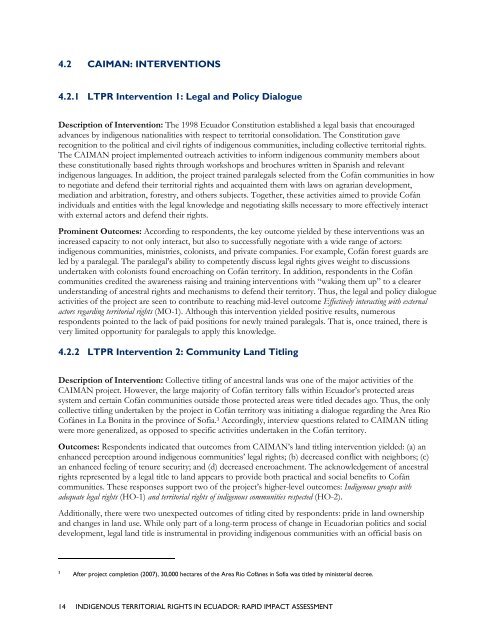ECUADOR - Land Tenure and Property Rights Portal
ECUADOR - Land Tenure and Property Rights Portal
ECUADOR - Land Tenure and Property Rights Portal
- No tags were found...
Create successful ePaper yourself
Turn your PDF publications into a flip-book with our unique Google optimized e-Paper software.
4.2 CAIMAN: INTERVENTIONS4.2.1 LTPR Intervention 1: Legal <strong>and</strong> Policy DialogueDescription of Intervention: The 1998 Ecuador Constitution established a legal basis that encouragedadvances by indigenous nationalities with respect to territorial consolidation. The Constitution gaverecognition to the political <strong>and</strong> civil rights of indigenous communities, including collective territorial rights.The CAIMAN project implemented outreach activities to inform indigenous community members aboutthese constitutionally based rights through workshops <strong>and</strong> brochures written in Spanish <strong>and</strong> relevantindigenous languages. In addition, the project trained paralegals selected from the Cofán communities in howto negotiate <strong>and</strong> defend their territorial rights <strong>and</strong> acquainted them with laws on agrarian development,mediation <strong>and</strong> arbitration, forestry, <strong>and</strong> others subjects. Together, these activities aimed to provide Cofánindividuals <strong>and</strong> entities with the legal knowledge <strong>and</strong> negotiating skills necessary to more effectively interactwith external actors <strong>and</strong> defend their rights.Prominent Outcomes: According to respondents, the key outcome yielded by these interventions was anincreased capacity to not only interact, but also to successfully negotiate with a wide range of actors:indigenous communities, ministries, colonists, <strong>and</strong> private companies. For example, Cofán forest guards areled by a paralegal. The paralegal’s ability to competently discuss legal rights gives weight to discussionsundertaken with colonists found encroaching on Cofán territory. In addition, respondents in the Cofáncommunities credited the awareness raising <strong>and</strong> training interventions with “waking them up” to a clearerunderst<strong>and</strong>ing of ancestral rights <strong>and</strong> mechanisms to defend their territory. Thus, the legal <strong>and</strong> policy dialogueactivities of the project are seen to contribute to reaching mid-level outcome Effectively interacting with externalactors regarding territorial rights (MO-1). Although this intervention yielded positive results, numerousrespondents pointed to the lack of paid positions for newly trained paralegals. That is, once trained, there isvery limited opportunity for paralegals to apply this knowledge.4.2.2 LTPR Intervention 2: Community <strong>L<strong>and</strong></strong> TitlingDescription of Intervention: Collective titling of ancestral l<strong>and</strong>s was one of the major activities of theCAIMAN project. However, the large majority of Cofán territory falls within Ecuador’s protected areassystem <strong>and</strong> certain Cofán communities outside those protected areas were titled decades ago. Thus, the onlycollective titling undertaken by the project in Cofán territory was initiating a dialogue regarding the Area RioCofánes in La Bonita in the province of Sofia. 3 Accordingly, interview questions related to CAIMAN titlingwere more generalized, as opposed to specific activities undertaken in the Cofán territory.Outcomes: Respondents indicated that outcomes from CAIMAN’s l<strong>and</strong> titling intervention yielded: (a) anenhanced perception around indigenous communities’ legal rights; (b) decreased conflict with neighbors; (c)an enhanced feeling of tenure security; <strong>and</strong> (d) decreased encroachment. The acknowledgement of ancestralrights represented by a legal title to l<strong>and</strong> appears to provide both practical <strong>and</strong> social benefits to Cofáncommunities. These responses support two of the project’s higher-level outcomes: Indigenous groups withadequate legal rights (HO-1) <strong>and</strong> territorial rights of indigenous communities respected (HO-2).Additionally, there were two unexpected outcomes of titling cited by respondents: pride in l<strong>and</strong> ownership<strong>and</strong> changes in l<strong>and</strong> use. While only part of a long-term process of change in Ecuadorian politics <strong>and</strong> socialdevelopment, legal l<strong>and</strong> title is instrumental in providing indigenous communities with an official basis on3After project completion (2007), 30,000 hectares of the Area Rio Cofánes in Sofia was titled by ministerial decree.14 INDIGENOUS TERRITORIAL RIGHTS IN <strong>ECUADOR</strong>: RAPID IMPACT ASSESSMENT
















